Connector uniaxial behavior | ||||||||||
|
| |||||||||
ProductsAbaqus/Explicit
Specifying uniaxial behavior for an available component of relative motion
Uniaxial behavior can be specified for an available component of relative motion by defining the loading and unloading response for that component. For each component, separate loading/unloading response data can be defined for the response in the tensile and compressive directions. The loading and unloading response can be classified according to three available behavior types:
nonlinear elastic behavior;
damaged elastic behavior; and
elastic-plastic type behavior with permanent deformation.
To define the loading response, you specify forces or moments as nonlinear functions of the components of relative motion. These functions can also depend on temperature, field variables, and constitutive displacements/rotations in the other component directions. See Input Syntax Rules for further information about defining data as functions of temperature and field variables.
The unloading response can be defined in the following ways:
You can specify several unloading curves that express the forces or moments as nonlinear functions of the components of relative motion; Abaqus interpolates these curves to create an unloading curve that passes through the point of unloading in an analysis.
You can specify an energy dissipation factor (and a permanent deformation factor for models with permanent deformation), from which Abaqus calculates an exponential/quadratic unloading function.
You can specify the forces or moments as nonlinear functions of the components of relative motion, as well as a transition slope; the connector unloads along the specified transition slope until it intersects the specified unloading function, at which point it unloads according to the function. (This unloading definition is referred to as combined unloading.)
You can specify the forces or moments as nonlinear functions of the components of relative motion; Abaqus shifts the specified unloading function along the strain axis so that it passes through the point of unloading in an analysis.
The behavior type that is specified for the loading response dictates the type of unloading you can define, as summarized in Table 1. The different behavior types, as well as the associated loading and unloading curves, are discussed in more detail in the sections that follow.
| Material behavior type | Unloading definition | ||||
|---|---|---|---|---|---|
| Interpolated | Quadratic | Exponential | Combined | Shifted | |
| Rate-dependent elastic | |||||
| Damaged elastic | |||||
| Permanent deformation | |||||
Input File Usage
Use the following options to define connector uniaxial behavior:
CONNECTOR BEHAVIOR, NAME=name CONNECTOR UNIAXIAL BEHAVIOR, COMPONENT=component number LOADING DATA, DIRECTION=deformation direction, TYPE=behavior type data lines to define loading data UNLOADING DATA data lines to define unloading data
Defining the deformation direction
The loading/unloading data can be defined separately for tension and compression by specifying the deformation direction. If the deformation direction is defined (tension or compression), the tabular values defining tensile or compressive behavior should be specified with positive values of forces/moments and displacements/rotations in the specified component of relative motion and the loading data must start at the origin. If the behavior is not defined in a loading direction, the force response will be zero in that direction (the connector has no resistance in that direction).
If the deformation direction is not defined, the data apply to both tension and compression. However, the behavior is then considered to be nonlinear elastic and no damage or permanent deformation can be specified. The response data will be considered to be symmetric about the origin if either tensile or compressive data are omitted.
Input File Usage
Use the following option to define tensile behavior:
LOADING DATA, DIRECTION=TENSION
Use the following option to define compressive behavior:
LOADING DATA, DIRECTION=COMPRESSION
Use the following option to define both tensile compressive behavior in a single table:
LOADING DATA
Behavior that depends on relative positions or motions in multiple component directions
By default, the loading and unloading functions depend only on the displacement or rotation in the direction of the component of relative motion specified for the connector uniaxial behavior definition (see Connector behavior for details). However, it is also possible to define loading and unloading functions that depend on the constitutive displacements and rotations in multiple component directions.
Input File Usage
Use the following option to define connector uniaxial behavior that depends on the relative displacements and/or rotations in several component directions:
LOADING DATA, INDEPENDENT COMPONENTS=CONSTITUTIVE MOTION
![]()
Defining rate-independent nonlinear elastic behavior
When the loading response is rate independent, the unloading response is also rate independent and occurs along the same user-specified loading curve as illustrated in Figure 1. An unloading curve does not need to be specified.
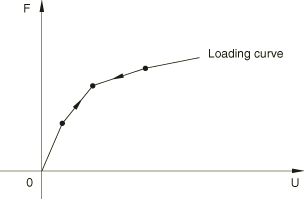
Input File Usage
LOADING DATA, TYPE=ELASTIC
![]()
Defining rate-dependent behavior
The rate-dependent models require the specification of force-displacement curves at different rates of deformation to describe both loading and unloading behavior. If unloading behavior is not specified, the unloading occurs along the loading curve with the smallest rate of deformation. As the rate of deformation changes, the response is obtained by interpolation of the specified loading/unloading data. Unphysical jumps in the forces due to sudden changes in the rate of deformation are prevented using a technique based on viscoplastic regularization. This technique also helps model relaxation effects in a very simplistic manner, with the relaxation time given as where , , and are material parameters and is the stretch. is a linear viscosity parameter that controls the relaxation time when . Small values of this parameter should be used. is a nonlinear viscosity parameter that controls the relaxation time at higher values of . The smaller this value, the shorter the relaxation time. controls the sensitivity of the relaxation speed to the stretch in the component of relative motion. Suggested values of these parameters are , , and . Figure 2 illustrates the loading/unloading behavior as the connector is loaded at a rate and then unloaded at a rate .
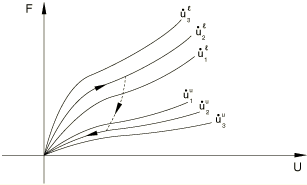
Figure 3 shows the loading/unloading response of a connector element for two different relaxation times and with . The larger the relaxation time, the longer it takes to achieve the specified loading/unloading response for the applied deformation rate.
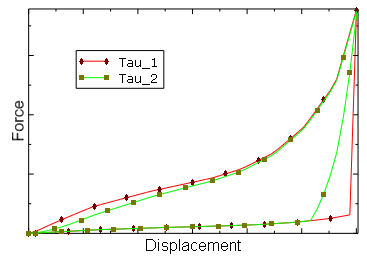
Input File Usage
Use the following options when the unloading is also rate dependent:
LOADING DATA, TYPE=ELASTIC, RATE DEPENDENT UNLOADING DATA, DEFINITION=INTERPOLATED CURVE, RATE DEPENDENT
Use the following options when the unloading is rate independent:
LOADING DATA, TYPE=ELASTIC, RATE DEPENDENT UNLOADING DATA, DEFINITION=INTERPOLATED CURVE
![]()
Defining models with damage
The damage models dissipate energy upon unloading, and there is no permanent deformation upon complete unloading. The unloading behavior controls the amount of energy dissipated by damage mechanisms and can be specified in one of the following ways:
an analytical unloading curve (exponential/quadratic);
an unloading curve interpolated from multiple user-specified unloading curves; or
unloading along a transition unloading curve (constant slope specified by user) to the user-specified unloading curve (combined unloading).
For an overview of the different available behaviors, see Specifying uniaxial behavior for an available component of relative motion above. The various unloading types are discussed in the sections that follow.
Defining onset of damage
You can specify the onset of damage by defining the displacement below which unloading occurs along the loading curve.
Input File Usage
LOADING DATA, TYPE=DAMAGE, DAMAGE ONSET=value
Specifying exponential/quadratic unloading
The damage model in Figure 4 is based on an analytical unloading curve that is derived from an energy dissipation factor, (fraction of energy that is dissipated at any displacement level). As the connector is loaded, the force follows the path given by the loading curve. If the connector is unloaded (for example, at point B), the force follows the unloading curve . Reloading after unloading follows the unloading curve until the loading is such that the displacement becomes greater than , after which the loading path follows the loading curve. The arrows shown in Figure 4 illustrate the loading/unloading paths of this model.

The unloading response follows the loading curve when the calculated unloading curve lies above the loading curve to prevent energy generation and follows a zero force response when the unloading curve yields a negative response. In such cases the dissipated energy will be less than the value specified by the energy dissipation factor.
Input File Usage
Use the following option to define quadratic unloading behavior:
UNLOADING DATA, DEFINITION=QUADRATIC
Use the following option to define exponential unloading behavior:
UNLOADING DATA, DEFINITION=EXPONENTIAL
Specifying interpolated curve unloading
The damage model in Figure 5 illustrates an interpolated unloading response based on multiple unloading curves that intersect the primary loading curve at increasing values of forces/displacements. You can specify as many unloading curves as are necessary to define the unloading response. Each unloading curve always starts at point O, the point of zero force and zero displacements, since the damage models do not allow any permanent deformation. The unloading curves are stored in normalized form so that they intersect the loading curve at a unit force for a unit displacement, and the interpolation occurs between these normalized curves. If unloading occurs from a maximum displacement for which an unloading curve is not specified, the unloading is interpolated from neighboring unloading curves. As the connector is loaded, the force follows the path given by the loading curve. If the connector is unloaded (for example, at point B), the force follows the unloading curve . Reloading after unloading follows the unloading path until the loading is such that the displacement becomes greater than , after which the loading path follows the loading curve.
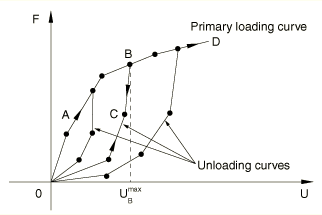
If the loading curve depends on the constitutive displacements/rotations in several component directions, the unloading curves also depend on the same component directions. The unloading curves also have the same temperature and field variable dependencies as the loading curve.
Input File Usage
UNLOADING DATA, DEFINITION=INTERPOLATED CURVE
Specifying combined unloading
As illustrated in Figure 6, you can specify an unloading curve in addition to the loading curve as well as a constant transition slope that connects the loading curve to the unloading curve. As the connector is loaded, the force follows the path given by the loading curve. If the connector is unloaded (for example, at point B), the force follows the unloading curve . The path is defined by the constant transition slope, and lies on the specified unloading curve. Reloading after unloading follows the unloading path until the loading is such that the displacement becomes greater than , after which the loading path follows the loading curve.
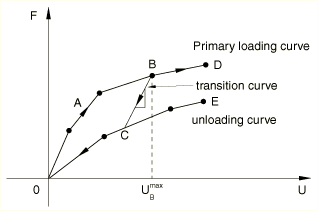
If the loading curve depends on the constitutive displacements/rotations in several component directions, the unloading curve also depends on the same component directions. The unloading curve also has the same temperature and field variable dependencies as the loading curve.
Input File Usage
UNLOADING DATA, DEFINITION=COMBINED
![]()
Defining models with permanent deformation
These models dissipate energy upon unloading and exhibit permanent deformation upon complete unloading. The unloading behavior controls the amount of energy dissipated as well as the amount of permanent deformation. The unloading behavior can be specified in one of the following ways:
an analytical unloading curve (exponential/quadratic);
an unloading curve interpolated from multiple user-specified unloading curves; or
an unloading curve obtained by shifting the user-specified unloading curve to the point of unloading.
For an overview of the different available behaviors, see Specifying uniaxial behavior for an available component of relative motion above. The various unloading types are discussed in the sections that follow.
Defining the onset of permanent deformation
By default, the onset of yield will be obtained as soon as the slope of the loading curve decreases by 10% from the maximum slope recorded up to that point while traversing along the loading curve. To override the default method of determining the onset of yield, you can specify either a value for the decrease in slope of the loading curve other than the default value of 10% (slope drop = 0.1) or by defining the displacement below which unloading occurs along the loading curve. If a slope drop is specified, the onset of yield will be obtained as soon as the slope of the loading curve decreases by the specified factor from the maximum slope recorded up to that point.
Input File Usage
Use the following options to specify the onset of yield by defining the displacement below which unloading occurs along the loading curve:
LOADING DATA, TYPE=PERMANENT DEFORMATION, YIELD ONSET=value
Use the following options to specify the onset of yield by defining a slope drop for the loading curve:
LOADING DATA, TYPE=PERMANENT DEFORMATION, SLOPE DROP=value
Specifying exponential/quadratic unloading
The model in Figure 7 illustrates an analytical unloading curve that is derived based on an energy dissipation factor, (fraction of energy that is dissipated at any displacement level) and a permanent deformation factor, . As the connector is loaded, the force follows the path given by the loading curve. If the connector is unloaded (for example, at point B), the force follows the unloading curve . The point D corresponds to the permanent deformation, . Reloading after unloading follows the unloading curve until the loading is such that the displacement becomes greater than , after which the loading path follows the loading curve. The arrows shown in Figure 7 illustrate the loading/unloading paths of this model.
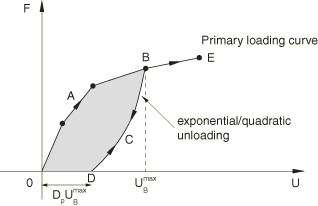
The unloading response follows the loading curve when the calculated unloading curve lies above the loading curve to prevent energy generation and follows a zero force response when the unloading curve yields a negative response. In such cases the dissipated energy will be less than the value specified by the energy dissipation factor.
Input File Usage
Use the following option to define quadratic unloading behavior:
UNLOADING DATA, DEFINITION=QUADRATIC
Use the following option to define exponential unloading behavior:
UNLOADING DATA, DEFINITION=EXPONENTIAL
Specifying interpolated curve unloading
The model in Figure 8 illustrates an interpolated unloading response based on multiple unloading curves that intersect the primary loading curve at increasing values of forces/displacements. You can specify as many unloading curves as are necessary to define the unloading response. The first point of each unloading curve defines the permanent deformation if the connector is completely unloaded. The unloading curves are stored in normalized form so that they intersect the loading curve at a unit force for a unit displacement, and the interpolation occurs between these normalized curves. If unloading occurs from a maximum displacement for which an unloading curve is not specified, the unloading curve is interpolated from neighboring unloading curves. As the connector is loaded, the force follows the path given by the loading curve. If the connector is unloaded (for example, at point B), the force follows the unloading curve . Reloading after unloading follows the unloading path until the loading is such that the displacement becomes greater than , after which the loading path follows the loading curve.
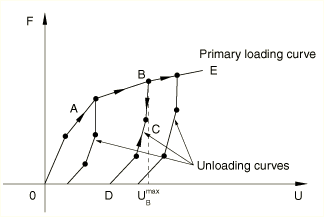
If the loading curve depends on the constitutive displacements/rotations in several component directions, the unloading curves also depends on the same component directions. The unloading curve also has the same temperature and field variable dependencies as the loading curve.
Input File Usage
UNLOADING DATA, DEFINITION=INTERPOLATED CURVE
Specifying shifted curve unloading
You can specify an unloading curve passing through the origin in addition to the loading curve. The actual unloading curve is obtained by horizontally shifting the user-specified unloading curve to pass through the point of unloading as shown in Figure 9. The permanent deformation upon complete unloading is the horizontal shift applied to the unloading curve.

If the loading curve depends on the constitutive displacements/rotations in several component directions, the unloading curve also depends on the same component directions. The unloading curve also has the same temperature and field variable dependencies as the loading curve.
Input File Usage
UNLOADING DATA, DEFINITION=SHIFTED CURVE
![]()
Using different uniaxial models in tension and compression
When appropriate, different uniaxial behavior models can be used in tension and compression. For example, a model with permanent deformation and exponential unloading in tension can be combined with a nonlinear elastic model in compression (see Figure 10).
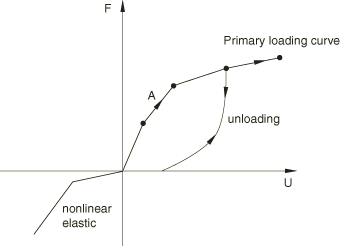
![]()
Output
The Abaqus output variables available for connectors are listed in Abaqus/Standard output variable identifiers and Abaqus/Explicit output variable identifiers. The following output variables are of particular interest when defining uniaxial behavior in connectors:
- CU
Connector relative displacements/rotations.
- CUF
Connector uniaxial forces/moments.